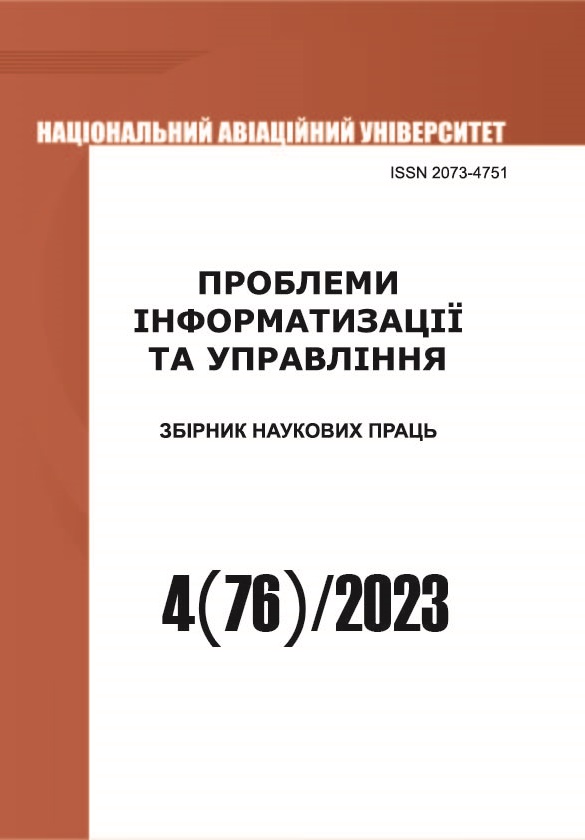Модель онтоголіко-реляційного сховища даних для функціонування хмарної SIEM-системи
DOI:
https://doi.org/10.18372/2073-4751.76.18236Ключові слова:
база даних, система управління базами даних, SIEM, онтологіко-реляційна модель, балансування навантаження, реплікація данихАнотація
Системи управління подіями інформаційної безпеки (SIEM) широко використовуються для запобігання втрат інформації у комп'ютерних системах і мережах. Наразі існують різні підходи до створення сховищ (баз) даних для SIEM-систем. В результаті проведеного аналізу не було виявлено універсального типу баз даних, а кожна з них має власні переваги і недоліки. Ця стаття націлена на дослідження відомих типів баз даних і систем управління ними, які можуть бути корисними для реалізації власної моделі сховища даних в сучасних SIEM. У роботі пропонується порівняльна характеристика їхніх можливостей, а також переваг і недоліків. Крім того, в роботі розроблено модель онтологіко-реляційного сховища даних, яка за рахунок використання двох різних баз даних з відповідними характеристиками, дозволяє покращити зручність у зберіганні та класифікації даних, забезпечити високу швидкість отримання великих обсягів інформації завдяки попередній індексації, а також балансування навантаження і реплікацію даних.
Посилання
Vielberth M., Pernul G. A Security Information and Event Management Pattern. 12th Latin American Conference on Pattern Languages of Programs (SugarLoafPLoP) / Valparaíso, Chile, 2018. 12 p.
Agrawal K., Makwana H. A Study on Critical Capabilities for Security Information and Event Management. International Journal of Science and Research (IJSR). V. 4. Iss. 7. P. 1893–1896.
Henrik Karlzén. An Analysis of Security Information and Event Management Systems. Department of Computer Science and Engineering Chalmers University of Technology University of Gothenburg, Göteborg, Sweden, January 2009. URL: http://publications.lib.chalmers.se/records/fulltext/89572.pdf.
Ribolovlev D., Karasov S., Polyakov S. Classification of emergency management systems for incidents without baking. Food of cyber security. 2018. No. 3(27). P. 47–53.
Ariel Query Language Guide. IBM QRadar 7.3.3 (2013 and 2019). URL: https://www.ibm.com/docs/en/SS42VS_7.3.3/com.ibm.qradar.doc/b_qradar_aql.pdf
SIEM Analytcis. URL: http://www.siem.su/compare_SIEM_systems.php
Lee J., Kim Y., Kim J., Kim I. Toward the SIEM architecture for cloud-based security services. 2017 IEEE Conference on Communications and Network Security (CNS) / Las Vegas, USA, 2017. P. 398–399.
Bachane I., Adsi Y.I.K., Adsi H.C. Real time monitoring of security events for forensic purposes in Cloud environments using SIEM. 2016 Third International Conference on Systems of Collaboration (SysCo) / Casablanca, Morocco, 2016. P. 1–3.
AlSabbagh B., Kowalski S. A Framework and Prototype for A Socio-Technical Security Information and Event Management System (ST-SIEM). 2016 European Intelligence and Security Informatics Conference (EISIC) / Uppsala, Sweden, 2016. P. 192–195.
Serckumecka A., Medeiros I., Bessani A. Low-Cost Serverless SIEM in the Cloud. 2019 38th Symposium on Reliable Distributed Systems (SRDS) / Lyon, France, 2019. P. 381–3811.
Nabil M., Soukainat S., Lakbabi A., Ghizlane O. SIEM selection criteria for an efficient contextual security. 2017 International Symposium on Networks, Computers and Communications (ISNCC) / Marrakech, Morocco, 2017. P. 1–6.
Mahmoud R.-V., Kidmose E., Turkmen A., Pilawka O., Pedersen J.M. DefAtt - Architecture of Virtual Cyber Labs for Research and Education. 2021 International Conference on Cyber Situational Awareness Data Analytics and Assessment (CyberSA) / Dublin, Ireland, 2021. P. 1–7.
Danik Yu., Hryschuk R., Gnatyuk S. Synergistic effects of information and cybernetic interaction in civil aviation. Aviation. 2016. V. 20. No. 3. P. 137–144.
Berdibayev R., Gnatyuk S., Yevchenko Yu., Kishchenko V. A concept of the architecture and creation for SIEM system in critical infrastructure. Studies in Systems, Decision and Control. 2021. V. 346. P. 221–242.
Oksiiuk O., Chaikovska V., Fesenko A. Security Technique for Authentication Process in the Cloud Environment. 2019 IEEE International Scientific-Practical Conference Problems of Infocommunications, Science and Technology (PIC S&T) / Kyiv, Ukraine, 2019. P. 379–382.
Gnatyuk S., Berdibayev R., Avkurova Z., Verkhovets O., Bauyrzhan M. Studies on cloud-based cyber incidents detection and identification in critical infrastructure. CEUR Workshop Proceedings. 2021. V. 2923. P. 68–80.
Lukova-Chuiko N., Fesenko A., Papirna H., Gnatyuk S. Threat hunting as a method of protection against cyber threats. CEUR Workshop Proceedings. 2021.V. 2833. P. 103–113.
Astapenya V., Buriachok V., Sokolov V., Skladannyi P., Ageyev D. Last mile technique for wireless delivery system using an accelerating lens. 2020 IEEE International Conference on Problems of Infocommunications Science and Technology (PIC S&T) / Kharkiv, Ukraine, 2020. P. 811–814.
Гнатюк С.О., Сидоренко В.М., Жигаревич О.К., та ін. Система корелювання подій та управління інцидентами кібербезпеки на об’єктах критичної інфраструктури. Кібербезпека: освіта, наука, техніка. 2023. Т. 3. № 19. С. 176–196.
##submission.downloads##
Опубліковано
Номер
Розділ
Ліцензія
Автори, які публікуються у цьому журналі, погоджуються з наступними умовами:- Автори залишають за собою право на авторство своєї роботи та передають журналу право першої публікації цієї роботи на умовах ліцензії Creative Commons Attribution License, котра дозволяє іншим особам вільно розповсюджувати опубліковану роботу з обов'язковим посиланням на авторів оригінальної роботи та першу публікацію роботи у цьому журналі.
- Автори мають право укладати самостійні додаткові угоди щодо неексклюзивного розповсюдження роботи у тому вигляді, в якому вона була опублікована цим журналом (наприклад, розміщувати роботу в електронному сховищі установи або публікувати у складі монографії), за умови збереження посилання на першу публікацію роботи у цьому журналі.
- Політика журналу дозволяє і заохочує розміщення авторами в мережі Інтернет (наприклад, у сховищах установ або на особистих веб-сайтах) рукопису роботи, як до подання цього рукопису до редакції, так і під час його редакційного опрацювання, оскільки це сприяє виникненню продуктивної наукової дискусії та позитивно позначається на оперативності та динаміці цитування опублікованої роботи (див. The Effect of Open Access).


